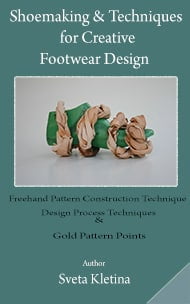Shoe making and Techniques
for Creative
Footwear Design
By
Sveta Kletina
Footwear Designer
www.shoemakingcoursesonline.com
Table of contents
Introduction. 3
- Classic models of shoes and why you need them. 4
- Must know pattern points or the secret of making correct pattern from the first time. 10
- Don’t wait for a muse, rely on design process techniques. 21
- The bad the good and the ugly- 3 Methods of footwear design. 24
- Shortcut to creative footwear design – Freehand Pattern Construction Technique. 34
- How to build an entire collection just with 2 types of lasts. 35
Introduction
I want to be inspired. I want to be inspired by artists, by creative and passionate people. My goal is to share my knowledge to inspire others, to create and innovate because the progress is made by innovators .
This book is all about creative design, about creative shoe making and techniques that you can use in your creations.
This is the first time I share my Freehand Pattern Construction Technique, that use in my work. This is the only natural 3D pattern making without using computer software technique and it’s protected by copyright laws. You are welcome to use it in your work but you cannot teach without my permission.
Sveta Kletina
1. Classic models of shoes and why you need them.
As you create your design you want to make the next Ferrari of shoes, but as building a luxury or any other car for that matter you have to know the rules for your design, so it won’t die in the development process. Knowing the rules gives you the creative freedom you need and push you one step forward towards realizing your creation. Great, now as we established that understanding, here are the rules and I think we are done. Well, it could be the case if I wanted to teach you a trick, but no tricks here, repeating the same formula, over and over again will just bring you from point A to point B, my intentions is to take you all the way.
Those rules are legislated by foot structure and characteristics of shoe models (types), that based on them all types of footwear designs was created, the classic shoes. Those types of models established their structure for many decades through the history, influenced by changes in the society, culture and fashion. To understand what are classic shoes, we need to follow one criteria. Classic shoes structure always looks the same, always has been and always will be. Try to think of it as of classical music, the composition always stays the same.
Although, there are many types of shoes that were created hundreds years ago, they fail to stand in this criteria, because their structure is not strict and can be interpreted in varies ways.
Classic shoes and different variations of their historical footwear family are playing important role in shoemaking history, not just as an origin for all shoe designs . According to them strict pattern points for making correct shoe design were found (full pattern points map- see chapter two). Using this method, shoe models are created so the shoe will feet perfectly and each of those types has their distinguished shoe last, that strictly stands in the requirements of this model(see chapter six).
As in this book I concentrate on women shoe design, one thing have to be clear, women classic shoe models are evolved from men classic models. They own very similar design and pattern, but the main difference between them is, that women shoes has more freedom in their structure as in a men shoes, the classic model has exact strict rules for making those types of patterns.
My primary list of classic women shoes as I see it, including four models that go by the same strict rules for centuries and will never change;
1. Derby shoes
2. Oxford shoes
3. Moccasin shoes
4. Pumps shoes
Derby shoes
Those are open lace shoes, in which the side parts are sewn on the front side.
That’s why when the laces are loose, the sides are wide open.



